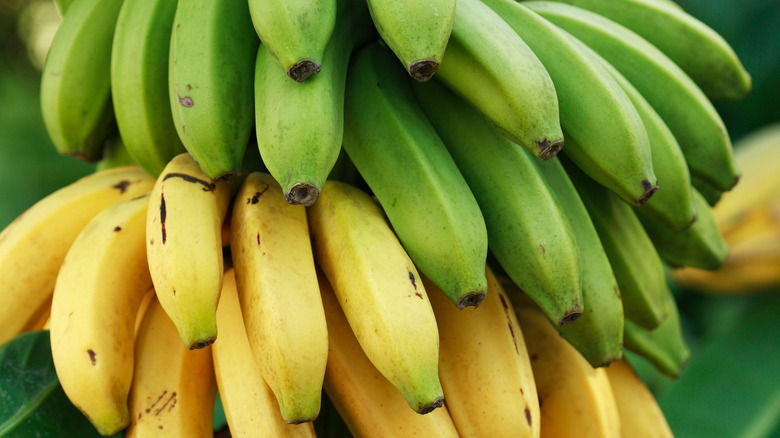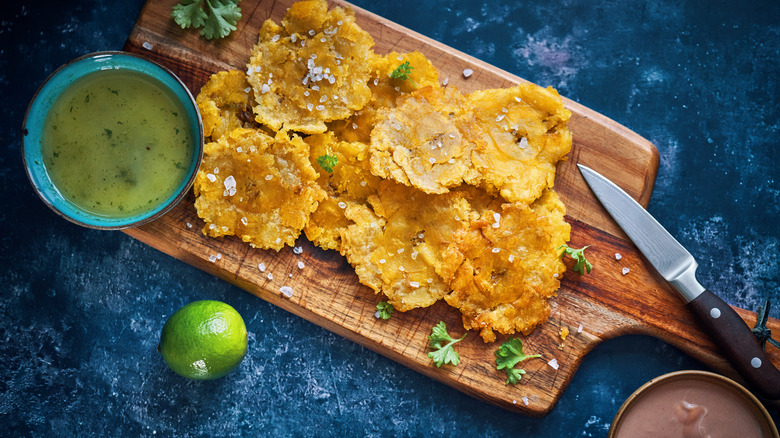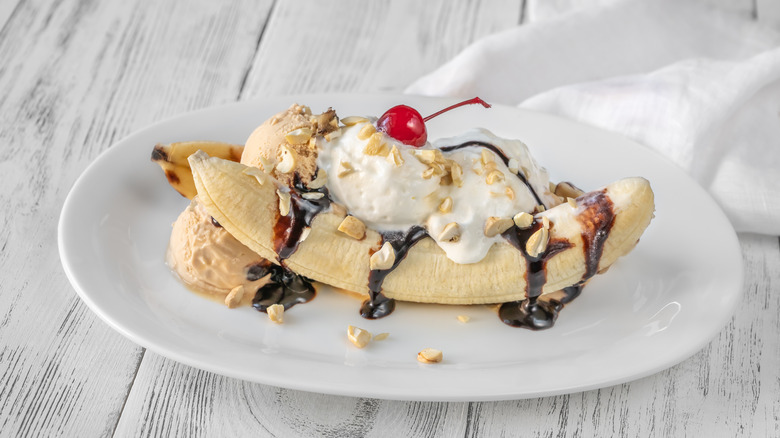What Is The Difference Between Bananas And Plantains?
It's easy to think of bananas and plantains as interchangeable for snacking or cooking purposes, but it's not totally true. While they look similar, both featuring an elongated, slightly curvy shape and bright yellow or green skins, the difference in texture and taste between the two is stark.
Bananas and plantains both originate in Southeast Asia and each comes from the same banana family, known as Musaceae. But their stories diverge when it comes to cooking and eating them, especially related to cultural preferences. Depending on the type of cuisine, plantains often appear in specialty dishes from Africa to the Caribbean, Asia, and Latin America whereas bananas have a bit more global appeal.
Another obvious difference is that plantains typically get cooked before consumption, while bananas are a delicious choice for raw snacking. Cooked dishes featuring starchy plantains have devoted followers on both sides of the sweet-or-savory divide, though they're traditionally treated more like vegetables than fruits. Bananas are often eaten as-is in their natural state, when the skins turn a bright-yellow color, which indicates the peak of ripeness. However, some cherished banana recipes do call for baking, grilling, or even flambeing with a torch.
The many ways to cook and enjoy plantains
Plantains tend to be typically larger, thicker, starchier, and have a lower sugar content than bananas, leading some to believe they have a bland taste. But those same characteristics make plantains ideal for savory cooked dishes, holding up well to boiling, grilling, and stovetop frying.
Plantain skins can be tough in the early underripe stage, when they are green or faintly yellow, so you'll need a small paring knife to slice through the thickness to remove the peel. Once you access the inner flesh, try boiling it with salt just as you would with potatoes, then mashing with butter and seasonings to taste. You could alternatively form them into patties for Jamaican-style fritters.
When they're underripe is also an ideal time for fried plantains. Thinly cut some pieces, and use an air fryer to make plantains chips, or cut chunkier pieces and deep-fry in oil, similar to french fries.
As the skins darken on plantains, signaling a past-prime ripeness, they get slightly sweeter and are ideal for dessert recipes. A favorite Puerto Rican dish called platanos maduros employs soft, ripe plantains, which are made extra sugary by caramelizing them in butter or oil.
With plantains growing prolifically in many parts of the world, the options for preparing and eating them are endless.
Sweet and semi-savory banana dishes
The 1000-plus banana varieties across the globe can differ widely. In Western cultures, the most common kind is hands-down the Cavendish banana, which is sweet, affordable, and easily available.
With inherent sweetness and soft texture, along with an ideal structure for handheld snacking, bananas are a favored choice for healthy eating, especially since they contain potassium, vitamin C, magnesium, fiber, and antioxidants. Bananas also feature beneficial complex carbohydrates, which have more sugars than plantains (which are starchier). This contributes to popular inclinations toward banana-centric desserts like the famous banana split.
Often considered a retro food because of its soda-fountain debut in the early 1900s, the banana split is one of the most legendary treats starring the fruit. What's not to love with three different flavors of ice cream, chocolate sauce, and sprinkles of nuts, topped with at least one bright-red cherry?
There's also the more sophisticated bananas foster extravaganza favored by adults, in which the bananas traditionally get caramelized with brown sugar and rum using the flambé method. Dozens of other classic recipes incorporate bananas, from puddings (affectionately dubbed nana puddin' in America's Deep South) to sheet cakes, pound cakes, cookies, and candied bananas. Breakfast in particular is a popular usage for the fruit: Think banana muffins, pancakes, yogurts, banana oatmeal, and prolific loafs of banana quick-breads with nuts and raisins.



